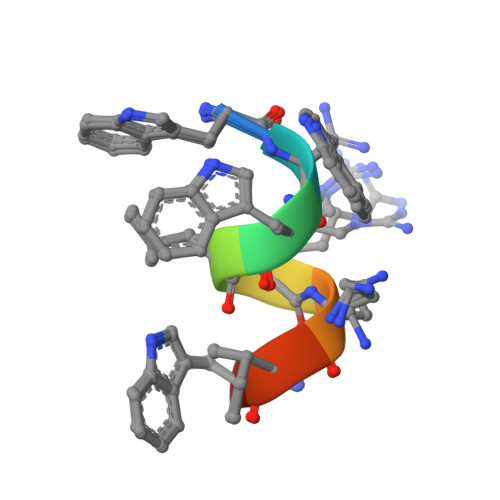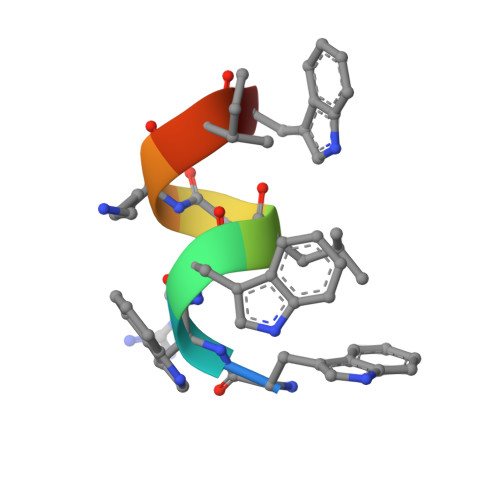The pi Configuration of the WWW Motif of a Short Trp-Rich Peptide Is Critical for Targeting Bacterial Membranes, Disrupting Preformed Biofilms, and Killing Methicillin-Resistant Staphylococcus aureus.
Zarena, D., Mishra, B., Lushnikova, T., Wang, F., Wang, G.(2017) Biochemistry 56: 4039-4043
- PubMed: 28731688
- DOI: https://doi.org/10.1021/acs.biochem.7b00456
- Primary Citation of Related Structures:
6NM2 - PubMed Abstract:
Tryptophan-rich peptides, being short and suitable for large-scale chemical synthesis, are attractive candidates for developing a new generation of antimicrobials to combat antibiotic-resistant bacteria (superbugs). Although there are numerous pictures of the membrane-bound structure of a single tryptophan (W), how multiple Trp amino acids assemble themselves and interact with bacterial membranes is poorly understood. This communication presents the three-dimensional structure of an eight-residue Trp-rich peptide (WWWLRKIW-NH 2 with 50% W) determined by the improved two-dimensional nuclear magnetic resonance method, which includes the measurements of 13 C and 15 N chemical shifts at natural abundance. This peptide forms the shortest two-turn helix with a distinct amphipathic feature. A unique structural arrangement is identified for the Trp triplet, WWW, that forms a π configuration with W2 as the horizontal bar and W1/W3 forming the two legs. An arginine scan reveals that the WWW motif is essential for killing methicillin-resistant Staphylococcus aureus USA300 and disrupting preformed bacterial biofilms. This unique π configuration for the WWW motif is stabilized by aromatic-aromatic interactions as evidenced by ring current shifts as well as nuclear Overhauser effects. Because the WWW motif is maintained, a change of I7 to R led to a potent antimicrobial and antibiofilm peptide with 4-fold improvement in cell selectivity. Collectively, this study elucidated the structural basis of antibiofilm activity of the peptide, identified a better peptide candidate via structure-activity relationship studies, and laid the foundation for engineering future antibiotics based on the WWW motif.
Organizational Affiliation:
Department of Pathology and Microbiology, College of Medicine, University of Nebraska Medical Center , 986495 Nebraska Medical Center, Omaha, Nebraska 68198-6495, United States.
















